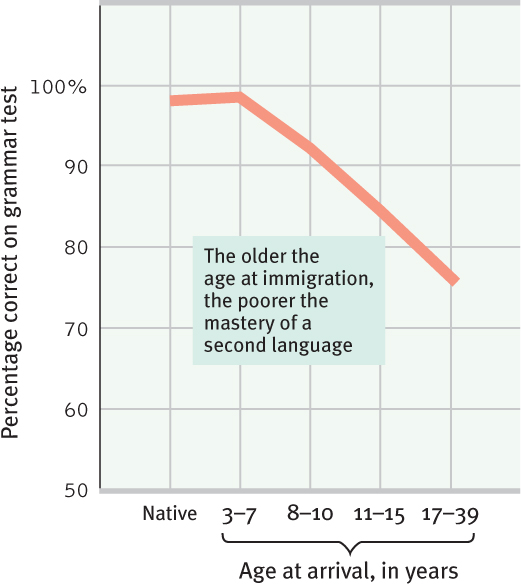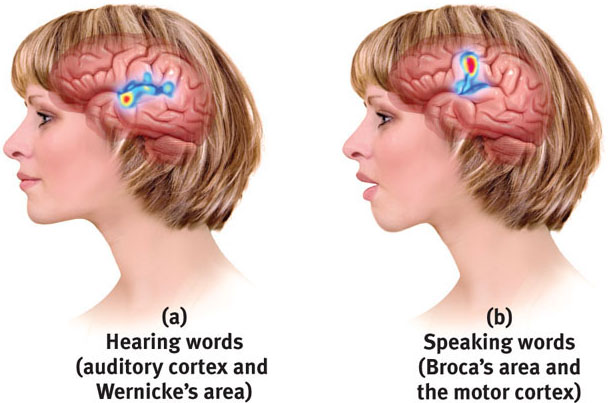Language
 Imagine an alien species that could pass thoughts from one head to another merely by setting air molecules in motion between them. Actually, we are those creatures! When we speak, we send air-pressure waves banging against other people’s eardrums as we transfer thoughts from our brain into theirs. As cognitive scientist Steven Pinker (1998) has noted, we sometimes sit for hours “listening to other people make noise as they exhale, because those hisses and squeaks contain information.” And thanks to all those funny sounds created from the air pressure waves we send out, we attract people’s attention and we get them to do things (Guerin, 2003). Depending on how you vibrate the air after opening your mouth, you may get a scowl or a kiss.
Imagine an alien species that could pass thoughts from one head to another merely by setting air molecules in motion between them. Actually, we are those creatures! When we speak, we send air-pressure waves banging against other people’s eardrums as we transfer thoughts from our brain into theirs. As cognitive scientist Steven Pinker (1998) has noted, we sometimes sit for hours “listening to other people make noise as they exhale, because those hisses and squeaks contain information.” And thanks to all those funny sounds created from the air pressure waves we send out, we attract people’s attention and we get them to do things (Guerin, 2003). Depending on how you vibrate the air after opening your mouth, you may get a scowl or a kiss.
Language is our spoken, written, or signed words, and the ways we meaningfully combine them. When I created this paragraph, my fingers on a keyboard triggered electronic signals that morphed into the squiggles in front of you. As you read these squiggles, they trigger nerve impulses that travel to areas of your brain that decode the meaning. Thanks to our shared language, information has just moved from my mind to yours. With language, we humans can transmit civilization’s knowledge from one generation to the next. Many animals know only what they see. Thanks to language, we know much that we’ve never seen and that our ancestors never knew.
230
Language also connects us. If you were able to keep only one cognitive ability, what would it be? Without sight or hearing, you could still have friends, family, and a job. But without language, could you have these things? “Language is so fundamental to our experience, so deeply a part of being human, that it’s hard to imagine life without it” (Boroditsky, 2009).
Language Development

8-7 What are the milestones in language development, and how do we acquire language?
Make a quick guess: How many words did you learn during the years between your first birthday and your high school graduation? Although you use only 150 words for about half of what you say, you probably learned about 60,000 words (Bloom, 2000; McMurray, 2007). That averages (after age 2) nearly 3500 words each year, or nearly 10 each day! How you did it—how those 3500 words could so far outnumber the roughly 200 words your schoolteachers consciously taught you each year—is one of the great human wonders.
Could you even now state your language’s rules of syntax (the correct way to string words together to form sentences)? Most of us cannot. Yet, before you were able to add 2 + 2, you were creating your own original sentences and applying these rules. As a preschooler, your ability to understand and speak your language was so great it would put to shame college students struggling to learn a foreign language.
We humans have an astonishing knack for language. Without blinking, we sample tens of thousands of words in our memory, effortlessly combine them with near-perfect syntax, and spew them out, three words a second (Vigliocco & Hartsuiker, 2002). We rarely form sentences in our minds before we speak them. Rather, our sentences organize themselves on the fly as we speak. And while doing all this, we also fine-tune our language to our social and cultural setting, following rules for speaking (How far apart should we stand?) and listening (Is it OK to interrupt?). Given how many ways there are to mess up, it’s amazing that we master this social dance. When and how does it happen?
When Do We Learn Language?
RECEPTIVE LANGUAGE Children’s language development moves from simplicity to complexity. Infants start without language (in fantis means “not speaking”). Yet by 4 months of age, babies can recognize differences in speech sounds (Stager & Werker, 1997). They can also read lips. They prefer to look at a face that matches a sound, so we know they can recognize that ah comes from wide open lips and ee from a mouth with corners pulled back (Kuhl & Meltzoff, 1982). This marks the beginning of the development of babies’ receptive language, their ability to understand what is said to and about them. At 7 months and beyond, babies grow in their power to break spoken sounds into individual words—which you and I find difficult when listening to an unfamiliar language.
PRODUCTIVE LANGUAGE Babies’ productive language, their ability to produce words, matures after their receptive language. Before nurture molds their speech, nature allows a wide range of possible sounds in the babbling stage, around 4 months of age. In this stage, they seem to sample all the sounds they can make, such as ah-goo. Babbling is not an imitation of adult speech. We know this because babbling includes sounds from languages not spoken in the household. From this early babbling, a listener could not identify an infant as being, say, French, Korean, or Ethiopian. Do deaf infants babble in sign language? They do, and those who observe their deaf parents signing begin to babble more with their hands (Petitto & Marentette, 1991).

By the time infants are about 10 months old, their babbling has changed so that a trained ear can identify the household language (de Boysson-Bardies et al., 1989). Without exposure to other languages, babies lose their ability to hear and produce sounds and tones found outside their native language (Meltzoff et al., 2009; Pallier et al., 2001). Thus, by adulthood those who speak only English cannot discriminate certain sounds in Japanese speech. Nor can Japanese adults with no training in English hear the difference between the English r and l. For a Japanese-speaking adult, la-la-ra-ra may sound like the same syllable repeated.
Around their first birthday, most children enter the one-word stage. They already know that sounds carry meanings. They now begin to use sounds—usually only one barely recognizable syllable, such as ma or da—to communicate meaning. But family members quickly learn to understand, and gradually the infant’s language sounds more like the family’s language. Across the world, baby’s first words are often nouns that label objects or people (Tardif et al., 2008). At this one-word stage, a single word (“Doggy!”) may equal a sentence (“Look at the dog out there!”).
231
At about 18 months, children’s word learning explodes, jumping from about a word each week to a word each day. By their second birthday, most have entered the two-word stage (TABLE 8.2). They start uttering two-word sentences in telegraphic speech. Like yesterday’s telegrams that charged by the word (TERMS ACCEPTED. SEND MONEY), a 2-year-old’s speech contains mostly nouns and verbs (Want juice). Also like telegrams, their speech follows rules of syntax, arranging words in a sensible order. English-speaking children typically place adjectives before nouns—white house rather than house white. Spanish reverses this order, as in casa blanca.
Moving out of the two-word stage, children quickly begin speaking in longer phrases (Fromkin & Rodman, 1983). What might happen if a child gets a late start on learning a particular language? This is not uncommon for children who have surgery to enable hearing, or who are adopted by a family in another country. For these late bloomers, language development follows the same sequence, though the pace is often faster (Ertmer et al., 2007; Snedeker et al., 2007). (But stay tuned: There is a limit on how long language learning can be delayed.)
By early elementary school, children understand complex sentences. They can enjoy a joke with a double meaning: “You never starve in the desert because of all the sand-which-is there.” 
RETRIEVE + REMEMBER
Question 8.3
What is the difference between receptive and productive language, and when do children normally hit these milestones in language development?
Infants normally start developing receptive language skills (ability to understand what is said to and about them) around 4 months of age. Then, starting with babbling at 4 months and beyond, infants normally start building productive language skills (ability to produce sounds and eventually words).
How Do We Learn Grammar?

The world’s 7000 or so languages are structurally very diverse (Evans & Levinson, 2009). Linguist Noam Chomsky has argued that all languages nevertheless share some basic elements, which he calls a universal grammar. Thus, all human languages have the same grammatical building blocks, such as nouns, verbs, and adjectives. Moreover, said Chomsky, we humans are born with a built-in readiness—a predisposition—to learn grammar rules. This helps explain why preschoolers pick up language so readily and use grammar so well. It happens so naturally—as naturally as birds learn to fly—that training hardly helps.
No matter what our language is, we start speaking mostly in nouns (kitty, da-da) rather than verbs and adjectives (Bornstein et al., 2004). We are not, however, born with a built-in specific language. Babies born in Mexico learn to speak Spanish, not Chinese. And whatever language we experience as children, whether spoken or signed, we readily learn its specific grammar and vocabulary (Bavelier et al., 2003). Once again, we see biology and experience working together.

CRITICAL PERIODS In The Fragile Species (1992), Lewis Thomas observed, “Childhood is the time for language, no doubt about it. Young children, the younger the better, are good at it; it is child’s play. It is a onetime gift to the species.” Childhood seems to represent a critical (or “sensitive”) period for mastering certain aspects of language (Hernandez & Li, 2007; Lenneberg, 1967). Deaf children who gain hearing with cochlear implants by age 2 develop better oral speech than do those who receive implants after age 4 (Greers, 2004). For deaf or hearing children, later-than-usual exposure to language—at age 2 or 3—unleashes their brain’s idle language capacity, producing a rush of language. But there is no similar rush of learning if children are not exposed to either a spoken or a signed language until age 7. Such deprived children lose their ability to master any language.
232
After the language window closes, even learning a second language becomes more difficult. Have you learned a second language as an adult? If so, you almost certainly speak it with the accent of your first, and perhaps with imperfect grammar.

The older we are when moving to a new country, the harder it is to learn the new culture and language (Cheung et al., 2011; Hakuta et al., 2003). This difficulty appeared in one study of Korean and Chinese immigrants (Johnson & Newport, 1991). Their task was to read 276 English sentences, such as “Yesterday the hunter shoots a deer,” and to decide whether each sentence was grammatically correct or incorrect. Everyone in the study had lived in the United States for approximately 10 years. Some had arrived as very young children, others as adults. As FIGURE 8.7 reveals, those who had learned their second language early learned it best.
The impact of early experience is also evident in sign language learning in children who have been deaf from birth. More than 90 percent of such children are born to hearing parents who do not use sign language. These children typically do not experience signed language during their early years. Those who learn to sign as teens or adults are in some ways like the immigrants who learned a new language after childhood. They can master the basic words and learn to order them. But they are never as fluent as native signers in using and understanding subtle differences in grammar (Newport, 1990). 
RETRIEVE + REMEMBER
Question 8.4
What was Noam Chomsky’s explanation of language development?
Chomsky maintained that all languages share a universal grammar, and humans are biologically predisposed to learn the grammar rules of language.
Question 8.5
Why is it so difficult to learn a new language in adulthood?
Our brain’s critical period for language learning is in childhood, when we can absorb language structure almost effortlessly. As we move past that stage in our brain’s development, our ability to learn a new language drops dramatically.
The Brain and Language
8-8 What brain areas are involved in language processing and speech?
We think of speaking and reading, or writing and reading, or singing and speaking as merely different examples of the same general ability—language. But consider this curious finding: Damage to any one of several areas of the brain’s cortex can impair language. Even more curious, some people with brain damage can speak fluently but cannot read (despite good vision). Others can understand what they read but cannot speak. Still others can write but not read, read but not write, read numbers but not letters, or sing but not speak. To sort out this puzzle required a lot of smart thinking by many different scientists, all seeking to answer the same question: How does the brain process language?
In 1865, French physician Paul Broca discovered that after damage to a specific area of the left frontal lobe (later called Broca's area) a person would struggle to speak words, yet could often sing familiar songs with ease. A decade later, German investigator Carl Wernicke discovered that after damage to a specific area of the left temporal lobe (Wernicke's area), people could speak only meaningless words and were unable to understand others’ words.
Over the next century and a half, other researchers continued the search for the answer to the language-processing puzzle. Today’s neuroscience has confirmed brain activity in Broca’s and Wernicke’s areas during language processing (FIGURE 8.8). But we now know that your brain processes language in other areas as well. You experience language as a single, unified stream. But functional MRI (fMRI) scans show that different neural networks in your brain are activated by nouns and verbs (or objects and actions); by different vowels; and by reading stories of visual versus motor experiences (Shapiro et al., 2006; Speer et al., 2009). And if you are lucky enough to be fluent in two languages, your hardworking brain has assigned those two functions to two different sets of neural networks. One processes your native language, and the other handles your second language (Perani & Abutalebi, 2005).

233
The big point to remember: In processing language, as in other forms of information processing, the brain operates by dividing its mental functions—speaking, perceiving, thinking, remembering—into smaller tasks. Your conscious experience of reading this page seems to be one task, but many different neural networks in your brain are pooling their work to compute each word’s form, sound, and meaning (Posner & Carr, 1992). 
RETRIEVE + REMEMBER
Question 8.6
___________ _____________is the part of the brain that, if damaged, might impair your ability to speak words. If you damage__________,___________, you might impair your ability to understand language.
Broca’s area; Wernicke’s area
Thinking Without Language
8-9 How can thinking in images be useful?
To turn on the cold water in your bathroom, in which direction do you turn the handle? To answer this question, you probably thought not in words but in images—perhaps a mental picture of your hand turning the faucet.
Indeed, we often think in images. Mental practice relies on thinking in images. One year after placing second in a worldwide piano competition, pianist Liu Chi Kung was imprisoned during China’s cultural revolution. Soon after his release, after seven years without touching a piano, Liu was back on tour. The critics judged his playing to be better than ever, and his fans wondered how he had continued to develop without practice. “I did practice,” said Liu, “every day. I rehearsed every piece I had ever played, note by note, in my mind” (Garfield, 1986).
How does mental practice work its magic? Once you have learned a skill, even watching that event will trigger brain activity in the same areas that are active when you actually use the skill. As ballet dancers watch ballet videos, fMRI scans show the brain dancing along (Calvo-Merino et al., 2004). Just imagining a physical experience, such as pain, can have similar results. Imagining pain activates neural networks that are normally active during actual pain (Grèzes & Decety, 2001).
One experiment on the benefits of mental practice observed the University of Tennessee women’s basketball team (Savoy & Beitel, 1996). Over 35 games, researchers tracked the team’s skill at shooting free throws following standard physical practice or mental practice. After physical practice, the team scored about 52 percent of their shots. After mental practice, that score rose to 65 percent. During mental practice, players had repeatedly imagined making free throws under various conditions, including being “trash-talked” by their opposition. In a dramatic conclusion, Tennessee won that season’s national championship game in overtime, thanks in part to their free throw shooting.
Can mental rehearsal also help you reach your academic goals? Definitely! One study demonstrated this with two groups of introductory psychology students facing a midterm exam one week later (Taylor et al., 1998). (A third control group did not engage in any mental rehearsal.) The first group spent five minutes each day imagining themselves scanning the posted grade list, seeing their A, beaming with joy, and feeling proud. This daily outcome simulation had little effect, adding only 2 points to their average exam score. The second group spent five minutes each day imagining themselves effectively studying—reading the chapters, going over notes, eliminating distractions, declining an offer to go out. This daily process simulation paid off. In real life, the group began studying sooner, spent more time at it, and beat the others’ average score by 8 points.
234
The point to remember: It’s better to spend your fantasy time planning how to get somewhere than to focus on the imagined destination. 
RETRIEVE + REMEMBER
Question 8.7
What is mental practice, and how can it help you to prepare for an upcoming event?
Mental practice uses visual imagery to mentally rehearse future behaviors, activating some of the same brain areas used during the actual behaviors. Visualizing the details of the process is more effective than visualizing only your end goal.
Do Other Species Have Language?
8-10 What do we know about other species’ capacity for language?
If in our use of language we humans are, as an ancient psalm says, “little lower than God,” where do other animals fit in the scheme of things? Are they “little lower than humans”?
Animals display great powers of understanding and communicating. Vervet monkeys sound different alarm cries for different predators: a barking call for a leopard, a cough for an eagle, and a chuttering for a snake. Hearing the leopard alarm, other vervets climb the nearest tree. Hearing the eagle alarm, they rush into the bushes. Hearing the snake chutter, they stand up and scan the ground (Byrne, 1991). To indicate complex alarms, such as the type of threat (eagle, leopard, falling tree, neighboring group) monkeys may combine 6 different calls into a 25-call sequence (Balter, 2010). But are such communications language? This question has launched many studies with chimpanzees.
In the late 1960s, psychologists Allen Gardner and Beatrix Gardner (1969) aroused enormous scientific and public interest when they taught sign language to a young chimpanzee named Washoe. After four years, Washoe could use 132 signs. By her life’s end in 2007, she was using 250 signs (Metzler, 2011). One New York Times reporter, having learned sign language from his deaf parents, visited Washoe and exclaimed, “Suddenly I realized I was conversing with a member of another species in my native tongue.”
During the 1970s, as more and more reports came in, it seemed apes might indeed be “little lower than human.” Some were stringing signs together to form sentences. Washoe, for example, signed “You me go out, please.” Some word combinations seemed very creative—saying water bird for “swan” or apple which-is orange for “orange” (Patterson, 1978; Rumbaugh, 1977).
By the late 1970s, some psychologists were growing skeptical. Were the chimps language champs or were the researchers chumps? Consider the skeptics’ points:


- Ape vocabularies and sentences are simple, rather like those of a 2-year-old child. And unlike speaking or signing children, who easily soak up dozens of new words a week (and 60,000 by adulthood), apes gain their limited vocabularies only with great difficulty (Wynne, 2004, 2008). Saying that apes can learn language because they can sign words is like saying humans can fly because they can jump.
- Chimpanzees can make signs or push buttons in sequence to get a reward. But pigeons, too, can peck a sequence of keys to get grain (Straub et al., 1979). The apes’ signing might be nothing more than aping their trainers’ signs and learning that certain arm movements produce rewards (Terrace, 1979).
- Studies of perceptual set (see Chapter 5) show that when information is unclear, we tend to see what we want or expect to see. Interpreting chimpanzee signs as language may be little more than the trainers’ wishful thinking (Terrace, 1979). When Washoe signed water bird, she may have been separately naming water and bird.
- “Give orange me give eat orange me eat orange…” is a far cry from the exquisite syntax of a 3-year-old (Anderson, 2004; Pinker, 1995). To the child, “You tickle” and “Tickle you” communicate different ideas. A chimpanzee, lacking human syntax, might use the same sequence of signs for both phrases.
Controversy can stimulate progress. In this case, it triggered more evidence of chimpanzees’ abilities to think and communicate. One surprising finding was that Washoe trained her adopted son Loulis to sign. After her second infant died, Washoe became withdrawn when told, “Baby dead, baby gone, baby finished.” Two weeks later, researcher caretaker Roger Fouts (1992, 1997) signed better news: “I have baby for you.” Washoe reacted with instant excitement. Hair on end, she swaggered and panted while signing over and again, “Baby, my baby.” It took several hours for the foster mom and infant to warm to each other. But then Washoe broke the ice by signing, “Come baby” and cuddling Loulis. In the months that followed, Loulis picked up 68 signs. He did this without human assistance, simply by observing Washoe and three other language-trained chimps signing together.

Even more stunning was a report that Kanzi, a bonobo, with a reported 384-word vocabulary, could understand syntax in spoken English (Savage-Rumbaugh et al., 1993, 2009). Kanzi has responded appropriately when asked, “Can you show me the light?” and “Can you bring me the [flash]light?” and “Can you turn the light on?” Given stuffed animals and asked—for the first time—to “make the dog bite the snake,” he put the snake to the dog’s mouth.
So, how should we interpret these studies? Are humans the only language-using species? If by language we mean verbal or signed expression of complex grammar, most psychologists would now agree that humans alone possess language. If we mean, more simply, an ability to communicate through a meaningful sequence of symbols, then apes are indeed capable of language.
One thing is certain. Studies of animal language and thinking have moved psychologists toward a greater appreciation of other species’ remarkable abilities (Friend, 2004; Rumbaugh & Washburn, 2003). In the past, many psychologists doubted that other species could plan, form concepts, count, use tools, show compassion, or use language (Thorpe, 1974). Today, thanks to animal researchers, we know better. Other animals exhibit insight, show family loyalty, communicate with one another, care for one another, and transmit cultural patterns across generations. Working out what this means for the moral rights of other animals is an unfinished task.
* * *
Thinking about other species’ abilities brings us back to a question raised earlier in this chapter: How smart are we? Do we deserve the label Homo sapiens? Let’s pause to issue an interim report card. On decision making and judgment, our smart but error-prone species might rate a B−. On problem solving and creativity, where humans are inventive yet subject to confirmation bias and fixation, we would probably receive better marks, perhaps a B+. On cognitive skills, our quick though sometimes faulty heuristics earn us an A. And when it comes to language and the processing that occurs outside of consciousness, the awestruck experts would surely award the human species an A+.
RETRIEVE + REMEMBER
Question 8.8
If your dog barks at a stranger at the front door, does this qualify as language? What if the dog yips in a telltale way to let you know she needs to go out?
These are definitely communications. But if language consists of words and the grammatical rules we use to combine them to communicate meaning, few scientists would label a dog’s barking and yipping as language.
